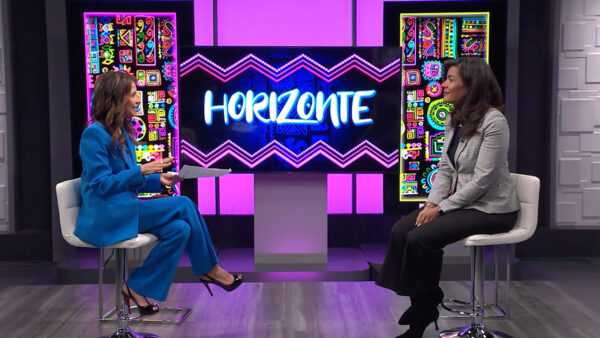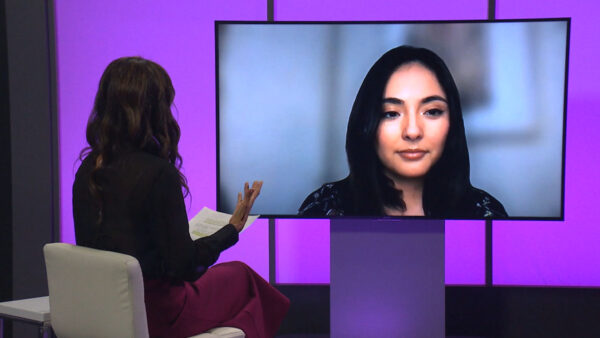CALA (Celebración ArtÃstica de las Américas) Alliance and ASU Art Museum launch Crossfade LAB. Crossfade LAB is a new program that presents discussions and art experiences highlighting internationally known Latino/Latina artists from Arizona and across the country.
ASU Art Museum Curator of CALA Initiatives Casandra Hernandez Faham and ASU Art Museum Curator Julio Morales discuss the program.
José Cárdenas: CALA, Celebración Artistica De Las Américas and asu art MUSEUM are launching the crossfade lab. With me to talk about CALA is Casandra Hernandez Faham, asu art museum's curator and Julio Morales. Tell us just a little bit of background.
Casandra Hernandez Faham: Celebración Artistica De Las Américas is an organization based here in Phoenix that creates art experiences that connect Latin Americans with Arizona. It creates new ways of investigating who we are, through the arts and connecting with the U.S. Mexico border, with Mexico and the rest of the Americas.
José Cárdenas: And It is called CALA alliance because it's a part of other entities. Tell us about that.
Casandra Hernandez Faham: We have a partnership with ASU art museum where we're working together to create new cultural investigations, new ways of understanding Latino arts and culture and reflecting on who we are here in Arizona and the ways in which our communities experience living in Phoenix and the state.
José Cárdenas: So, Julio, crossfade lab, what does that mean?
Julio Morales: It's a DJ's technique where you mix two sounds into one. The track we're trying to combine for this Monday's event is basically the mixing of different cultures, sounds, landscape, fusing together to create a really amazing performance and talk.
José Cárdenas: Let's talk about some of the people who will be participating. Part of it is a panel discussion, moderated by josh Coon, who's very prominent -- he's with USC.
Julio Morales: He's written about six books, Latino culture and music. And he also writes for the New York Times.
José Cárdenas: We've got a picture of him up on the screen. One of the other participants is pictured here. He's principally out of San Francisco, is that right?
Casandra Hernandez Faham: He's out of San Francisco. He's an experimental composer and known for pushing the boundaries for competition. A project that he has right now is centered on collecting objects along the border and creating instruments that reflect the human stories, the landscapes and the realities of the U.S./Mexico border.
José Cárdenas: Julio, the last person we'll be presenting -- here's another picture in an interesting pose. I assume that's a piano?
Julio Morales: And a violin.
José Cárdenas: A prominent Mexican artist.
Julio Morales: They represented Mexico last time. It is really the most important exhibition in the world. Each country chooses an artist to represent in Venice. So they have been working on various difference projects that involve technology and memory and sound and landscape so she's very interested in coming here. She's going to transform our hole in the rock, the prominent 3000-year old mountain we have, into a sound system.
José Cárdenas: Well that sounds pretty interesting. Before we get into the specifics of this program, how did you get these people here? I know you've been working on it for a while?
Julio Morales: When I first approached CALA to develop this project, the first person I talked to was josh and essentially, his connection to Latin America so we thought this would be a really great way to approach a conversation in a non-traditional way. We'll have performances, a conversation and demos. This is the second time that we do this presentation and they'll be a couple more, as well, throughout the year.
José Cárdenas: We've got a couple pictures we're going to put on the screen that illustrate what we're talking about. Talk to us about radio healer?
Casandra Hernandez Faham: Radio healer is a Phoenix collective of Native American and Chicano artist and they hack electronic devices and create instruments, like, what you're seeing on the screen.
José Cárdenas: There's sound that comes out of that?
Casandra Hernandez Faham: Right.
Casandra Hernandez Faham: Play stations.
Julio Morales: Remote controls.
Casandra Hernandez Faham: Pretty much everything they can get their hands on. And they create these instruments to reimagine indigenous ceremonies so it's a very performative kind of music and they're going to be performing as part of crossfade lab on Monday, which is also, you know, just a very immersive and visual, beautiful performance.
José Cárdenas: This next image we have, what does that represent?
Casandra Hernandez Faham: That is part of the ceremony I was speaking about. That's an artist based in mesa, who is playing one of the radio healer hat electronics.
Julio Morales: And in a way it's a new tradition and approach to ceremony and how they are working today.
José Cárdenas: As I understand it, we're not going to go and see a panel discussion and then a performance or a performance and then a panel discussion.
Julio Morales: We'll go from channel A and channel B and it will be mixed in a way that's very exciting and vibrant. There's really amazing conversations that should take place and so, we're trying to make it as dynamic as possible.
Casandra Hernandez Faham: We're creating a --
José Cárdenas: We've got a video I want to make sure we show now. We're going to put that up.
Julio Morales: One of the sculpture pieces. [Video playing]
José Cárdenas: And, so we're going to see that. Remind us again?
Casandra Hernandez Faham: Monday, April 18 at the ASU secret garden. You can find more information about the event on Facebook, if you search CALA alliance. We're creating a beautiful space with projection so that it'll be a very beautiful spring night.
José Cárdenas: Is there an admissions charge?
Casandra Hernandez Faham: It's a free event.
José Cárdenas: Julio, you indicated this has been done once before. What are you looking for in terms of developing and presenting this to the Phoenix market?
Julio Morales: I think we're looking at perhaps as part of CALA's initiative and their way of looking at how do we present and how do we preserve Latino culture and how do we do this, now, and how do we do this in the future?
José Cárdenas: Looks like it's going to be a lot of fun.
Casandra Hernandez Faham: It will be.
José Cárdenas: And some interesting people in Phoenix. Thanks so much for joining us.
José Cárdenas: That's our show for tonight. From all of us here at "Horizonte" and your Arizona PBS Station, I'm José Cárdenas. Have a good evening. CAPTIONING PERFORMED BY LNS CAPTIONING www.lnscaptioning.com.
Video: "Horizonte" is made possible by Arizona PBS, members of your PBS station. Thank you.
Casandra Hernandez Faham: Art Museum Curator of CALA Initiatives, Julio Morales: ASU Art Museum Curator























